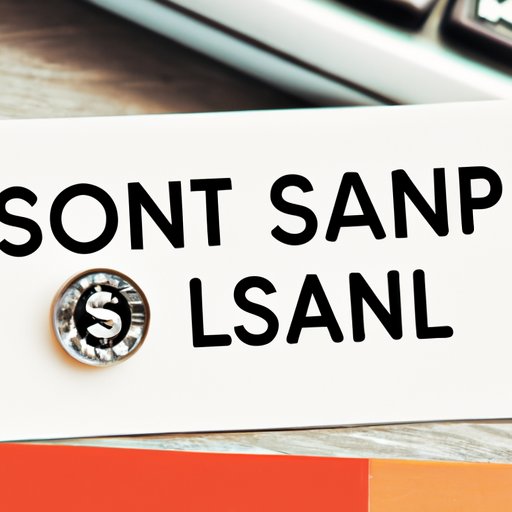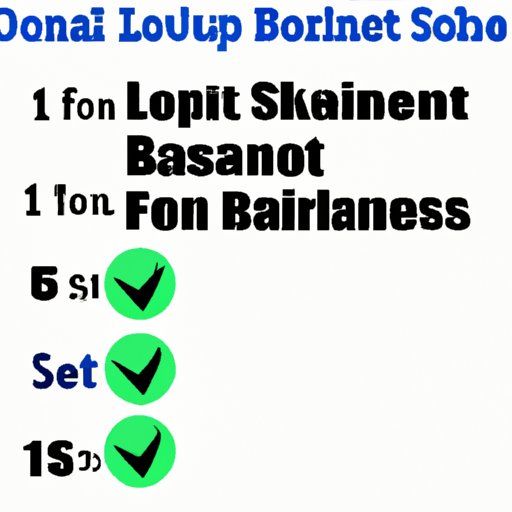
I. Introduction
Running a small business can be rewarding, but it can also be challenging, especially when it comes to securing financing. Whether you’re just starting out or looking to expand, obtaining a small business loan can help you achieve your goals. In this guide, we’ll take a comprehensive look at the steps you need to take to secure a small business loan.
A. Definition of Small Business Loan
A small business loan is a type of funding provided by financial institutions to small business owners to help them grow and expand their operations or to support daily business activities. Small business loans can also be used for equipment purchases, inventory management, payroll, and other business-related expenses.
B. Importance of Small Business Loans
Small business loans provide entrepreneurs with the financial support they need to succeed. Obtaining a small business loan is essential for small business owners who don’t have enough cash flow to fund their business operations. Small business loans can also help businesses purchase new equipment, expand their operations, and hire new employees.
C. Overview of the Article
In this guide, we’ll take a look at the 10 steps you need to follow to secure a small business loan. We’ll cover the various types of small business loans and how to apply for them. We’ll also discuss the key factors to consider before applying for a small business loan and the strategies you can use to improve your chances of approval. Finally, we’ll explore how to choose the right loan for you and your business.
II. 10 Steps to Securing a Small Business Loan
A. Research and Understand Your Options
The first step in securing a small business loan is to research and understand your options. There are many types of small business loans available, each with its own requirements and terms. Start by researching the various types of loans, including SBA loans, term loans, business lines of credit, business credit cards, and invoice financing.
B. Determine How Much Funding You Need
Before applying for a small business loan, determine how much funding you need. Consider the cost of your business operations, equipment purchases, and any expansion plans you may have. It’s essential to determine the exact amount of funding required to avoid taking on too much or too little debt.
C. Strengthen Your Personal and Business Credit Scores
Credit scores are a crucial factor in securing a small business loan. Both your personal and business credit scores will be considered when applying for a loan. To increase your chances of approval, ensure that your credit scores are as high as possible. Pay your bills on time, keep your credit utilization low, and dispute any errors on your credit report.
D. Get Your Financial Statements in Order
Organize your financial statements before applying for a small business loan. Financial statements include your balance sheet, income statement, and cash flow statement. Ensure that your financial statements are accurate and up-to-date to present a positive image of your business to potential lenders.
E. Prepare a Detailed Business Plan
A detailed business plan is essential when applying for a small business loan. Your business plan should outline your business’s goals, products or services, target market, competition, and financial projections. A detailed business plan demonstrates to lenders that you understand your business’s market and have a plan to succeed.
F. Gather all the Necessary Documentation
Gather all the necessary documentation before applying for a small business loan. Documentation requirements vary depending on the type of loan, but generally, lenders will want to see financial statements, bank statements, tax returns, and business licenses and permits.
G. Identify Potential Lenders
Identify potential lenders based on the type of loan you need and the lender’s eligibility requirements. Research potential lenders to determine their reputation, experience, and interest rates. Speak to other small business owners for recommendations and read online reviews.
H. Submit Your Loan Application
Submit your loan application once you’ve chosen a potential lender. Complete the application thoroughly and honestly, providing all of the required documentation and answering any questions truthfully.
I. Wait for a Decision
After submitting your loan application, you’ll need to wait for a decision from the lender. This can take anywhere from a few days to a few weeks, depending on the lender and the complexity of your loan application.
J. Close the Loan
If your loan application is approved, you’ll need to close the loan. This involves signing the loan agreement and any additional documentation required by the lender. Once the loan is closed, the funds will be deposited into your business bank account.
III. 5 Types of Small Business Loans and How to Apply for Them
A. SBA Loans
Small Business Administration (SBA) loans are government-backed loans available to small businesses. SBA loans are available in various forms, including 7(a) loans, CDC/504 loans, and microloans. To apply for an SBA loan, you’ll need to visit your local SBA lender and provide documentation such as business and personal tax returns, a business plan, financial statements, and collateral.
B. Term Loans
Term loans are traditional loans provided by banks or financial institutions that are repaid over a set term. To apply for a term loan, you’ll need to provide financial statements, business tax returns, and a business plan. Some lenders may also require collateral.
C. Business Lines of Credit
Business lines of credit provide a revolving line of credit that can be used for business expenses such as working capital, inventory management, and purchasing equipment. To apply for a business line of credit, you’ll need to provide financial statements, business tax returns, and a business plan. Lenders may also require collateral.
D. Business Credit Cards
Business credit cards are similar to personal credit cards but are designed for business expenses. Business credit cards provide a revolving line of credit that can be used for business expenses such as travel, dining, and office supplies. To apply for a business credit card, you’ll need to provide your personal and business tax information.
E. Invoice Financing
Invoice financing provides funding based on unpaid customer invoices. The invoice is used as collateral, and the lender provides funding based on the invoice’s value. To apply for invoice financing, you’ll need to provide copies of unpaid invoices and your business financial statements.

IV. Top 5 Strategies for Improving Your Small Business Loan Approval Odds
A. Improve Your Credit Score
Your credit score is a crucial factor in small business loan approvals. Improving your credit score by paying your bills on time, keeping your credit utilization low and fixing any errors on your credit report can improve your chances of approval.
B. Build up Your Cash Reserves
Lenders want to see that you have enough cash reserves to cover any unexpected expenses or downturns in business. Building up your cash reserves by saving part of your business profits can demonstrate to lenders that you’re financially responsible.
C. Provide Collateral
Providing collateral can improve your chances of approval for a small business loan. Collateral provides lenders with added security in case you’re unable to repay the loan.
D. Provide a Personal Guarantee
Providing a personal guarantee demonstrates to lenders that you’re personally liable for repaying the loan if your business is unable to do so. This provides lenders with added security and can improve your chances of approval.
E. Improve Your Business Financials
Improving your business’s financials by reducing expenses, increasing profits, and demonstrating a solid financial plan can improve your chances of approval for a small business loan.
V. The Ins and Outs of Small Business Loan Requirements and Eligibility Criteria
A. Basic Eligibility Requirements
Basic eligibility requirements for small business loans include having a viable business model and a reasonable level of financial stability. Other factors that lenders consider include your credit score, time in business, and revenue level.
B. Documentation Requirements
Documentation requirements for small business loans vary depending on the lender and the type of loan. Common documentation requirements include business financial statements, tax returns, business licenses and permits.
C. Character and Credit Requirements
Lenders will consider your personal and business credit score when evaluating your loan application. A good credit score indicates that you’re financially responsible and able to manage your debts effectively.
D. Cash Flow Requirements
Cash flow requirements are evaluated to determine the ability of your business to manage loan repayments. Lenders want to see that your business generates sufficient cash flow to cover loan repayments and other business expenses.
E. Collateral Requirements
Collateral requirements vary depending on the lender and the type of loan. Collateral provides lenders with security in the case of non-payment, and lenders may require collateral to approve your loan application.
VI. 5 Key Factors to Consider Before Applying for a Small Business Loan
A. How Much You Need
Determining the exact amount you need is essential to avoid taking on too much debt or failing to secure enough funding for your business needs.
B. How Soon You Need It
Consider your timeline for obtaining funding and ensure that you apply for a loan with enough time to secure the funds before you need them.
C. Your Ability to Repay
Determine your ability to repay the loan by evaluating your business’s financials and cash flow. Ensure that you have enough revenue to cover loan repayments and can demonstrate a solid financial plan.
D. The Cost of the Loan
Ensure that you understand the cost of the loan, including interest rates, fees, and repayment terms, before applying.
E. The Collateral Required
Consider the collateral required and ensure that you have assets that can be used as collateral if required.
VII. Small Business Loans: How to Choose the Right Loan for You and Your Business
A. Compare Rates and Terms
Compare interest rates, fees, and repayment terms from multiple lenders to ensure that you choose the loan that best fits your business needs and budget.
B. Consider the Lender’s Reputation and Experience
Research the lender’s reputation and experience in providing small business loans. Look for reviews and testimonials from other small business owners who have used their services.
C. Check for Hidden Fees and Charges
Review the loan agreement for any hidden fees or charges, such as prepayment penalties or origination fees.
D. Make Sure the Loan Meets Your Needs
Ensure that the loan meets your business needs and can provide the necessary funding for your business operations, expansion plans, or equipment purchases.
VIII. Conclusion
A. Recap of the Steps to Securing a Small Business Loan
Securing a small business loan involves 10 key steps, including researching your options, determining how much funding you need, preparing a detailed business plan, gathering all the necessary documentation, identifying potential lenders, submitting your loan application, and closing the loan.
B. Summary of Key Takeaways
Key takeaways from this guide include the importance of credit scores in small business loan approvals, the types of small business loans available, and the factors to consider when applying for a small business loan.
C. Final Thoughts and Recommendations
If you’re a small business owner looking to secure financing, it’s essential to understand the steps involved in securing a small business loan and the various types of loans available. Follow the steps outlined in this guide, and consider working with an experienced financial advisor to help increase your chances of approval and choosing the best loan for your business.





